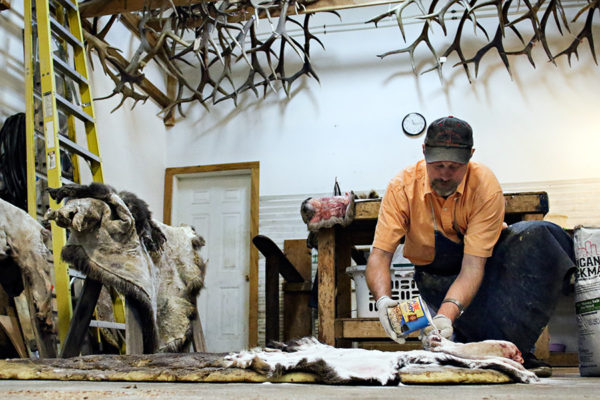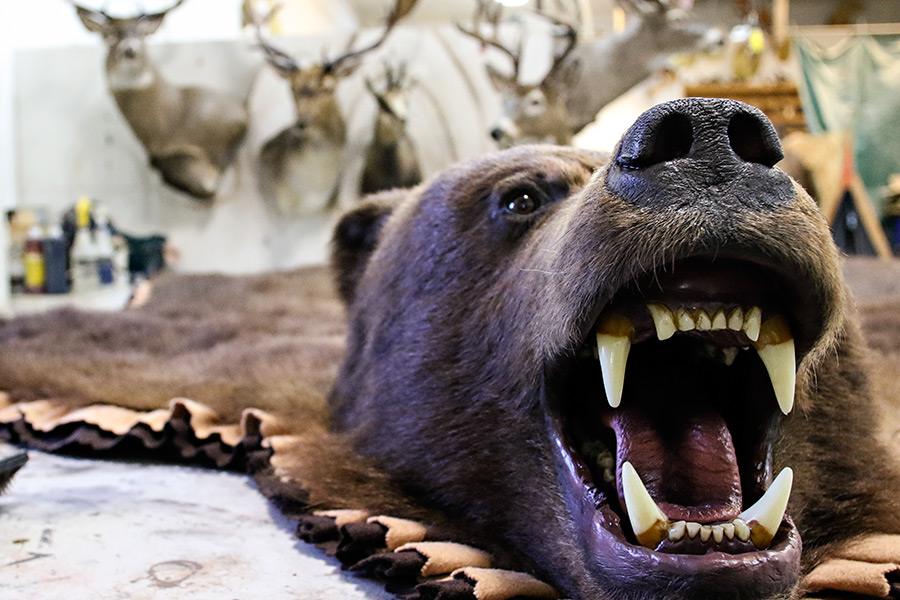A pair of glass eyes peers up from the worktable, casting a watchful glance at the rows of deer mounts, moose and locking elk antlers adorning the walls at the Montana Taxidermist in Kalispell, as well as the snow-white mountain goat skin and head a few feet away.
Nearby, an Alaskan brown bear lies prostrate on a workbench, its jaws set open like a steel trap, jagged teeth and gums glistening under the shop’s lights. All around the expansive building, piles of wild game skins are stacked, sorted or stretched out in various stages of completion, waiting to be fleshed, salted or tanned — and, ultimately, destined to strike a permanent pose that imitates their natural beauty.
For nearly 45 years, the man behind these carnal creations has been Bruce Babcock, who stood out as the longest-working taxidermist in the Flathead Valley, having opened shop in 1972 with his wife, Trisha, and built a reputation as among the best in the business.
As a dedicated hunter, Babcock cultivated a lifelong passion for the pursuit of wild game, but as much as he loved harvesting animals from the wilds of Montana, he was even more dedicated to reanimating them, and preserving the specimens as close to their natural state as possible.
It was that spirit that drew Babcock to the business, art and science of taxidermy — after the pursuit of the hunt, he could continue to pursue the beauty he encountered outdoors, while educating himself on the untold intricacies of the anatomy of the animals.
Babcock’s decades of work came to an end last month, when on Oct. 22, at the age of 71, he died after an 18-month-long battle with brain cancer, ending a legacy that filled freezers and trophy rooms alike.

When Babcock started the Montana Taxidermist in 1972, there was just one other taxidermist in the region, and he quickly adopted the view that his chosen craft would entail a lifelong dedication to learning its finer points.
Indeed, early practitioners of taxidermy often did so in the name of science, as naturalists like Charles Darwin learned the trade in order to preserve species for research purposes; had Darwin not learned the skill, he would not have been allowed to travel as a naturalist on the HMS Beagle.
And as modern practitioners can attest to, there is more to taxidermy than merely “stuffing” an animal, which is actually a misnomer — the word taxidermy comes from the Greek words “taxis,” or arrangement, and “derma,” or skin.
“It’s like a big upholstery job,” said Babcock’s wife, Trisha, whose primary responsibilities at the Montana Taxidermist have been sewing and finishing work, including touching up the animals’ faces with paint and sewing the skin and head to a pre-made form.
When the Babcocks started their business, they were still building forms out of papier mache, a tedious job compared to today’s custom of purchasing mannequins that can be sculpted to achieve a desired position.
“It’s a lot easier now because you don’t have to do as much modeling and casting, but his aim was always for accuracy,” Trisha said. “He had a great appreciation of the natural beauty of wildlife and he loved being out in the woods to study them.”
Born in Dillon, Babcock spent his early years in Plains before the family moved to Snohomish, Washington, where his father started a mink ranch. It was during high school while cutting his teeth as a hunter that he began experimenting with taxidermy.
“As a teenager, Bruce did a lot of bird hunting,” Trisha said. “He thought they were so beautiful, so he taught himself to mount them.”
In 1965, he joined the Air Force stationed in Bangor, Maine, eventually transferring to the Fairchild Air Force Base in Spokane, where he met Trisha.
When he and Trisha were married in 1969, Babcock was working on another mink ranch in Everett, Washington, but continued pursuing his passion for hunting and taxidermy in his free time, mounting ducks at the kitchen table.
After the mink rancher went out of business, he decided to pursue taxidermy full-time, signing on as an apprentice in Bellingham, Washington, where he worked for 18 months, making $1.90 an hour.
Trisha said she supported her husband’s chosen profession from the get-go, despite it lacking a certain glamor.
“He’d been mounting ducks at the kitchen table, so at least this got him out of the kitchen,” Trisha said, laughing. “He was so passionate about it you couldn’t help but support him.”
Eager to return to Montana, the Babcocks opened their taxidermy business in 1972, working out of a cabin on Lake Blaine before moving to a shop on LaSalle Road two years later.
They’d remain there for 29 years, although there were stumbling blocks along the way. In 1978, burglars stole a number of elk, deer and sheep heads, including a record-book bighorn sheep.
“That was pretty devastating to us and our customers,” Trisha said. “It was pretty hard to go forward after that. For a few weeks, Bruce wondered if he should continue with the business, but we just plugged along.”
Babcock continued to mount a reputation as the preeminent taxidermist in the Flathead, helping to found the Montana Taxidermy Guild in the 1980s, an organization that would later become the Montana Taxidermist Association.
He and Trisha raised three children and seven grandchildren, who hunted annually with Babcock at the family’s cabin up McGinnis Meadows, until he became too weak to embark on the outings.
About 10 years ago, after relocating to their current shop on Helena Flats Road, the Babcocks hired a part-time employee, Russ McAllister, an accomplished taxidermist in his own right, who helped the family business churn through skins during the busy season.

With Babcock’s recent passing, McAllister is taking over the business, while Trisha will stay on to help with bookkeeping, finishing work and sewing.
“I learned a tremendous amount from him over the years. Our primary goal was always production, but he always took the time to help me along,” McAllister said. “That’s something that I couldn’t have learned anywhere else. He had vast amounts of knowledge, not only about the craft but about the anatomy of wildlife.”
McAllister said he’s not trying to fill Babcock’s shoes, but rather carry on the legacy that his mentor began more than four decades ago.
“That’s a testament to the work he and Trisha did over the years. Any business that can last over 40 years, that shows the kind of success and talent they’ve developed over the years,” McAllister said.
